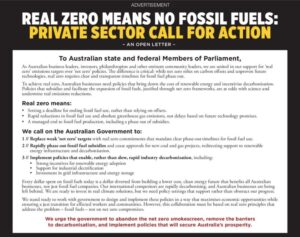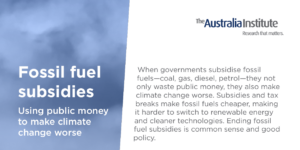by Richard Denniss
[Originally published on Guadian Australia, 19 Feb 2020]
After a summer of catastrophic bushfires, the most brutal evidence of the impacts of climate change, the Government has managed to move the debate towards the ‘pros and cons’ of setting a long-term net zero emissions target for 2050. Well played, Scott Morrison.
While #Scottyfrommarketing copped flack for his lack of empathy or response to the summer of fires, you have to admit, he’s done an amazing job of shifting the debate away from the Coalition’s failure to reduce emissions or prepare for the fires they were warned of by 24 former fire and emergency chiefs.
As Australia’s forests (and international credibility) burned, Morrison took a match to common sense and got away with it. Apparently, arsonists and bureaucrats caused the bushfires, drilling for more gas reduces emissions and we need to debate what happens in 2050 rather than what Morrison needs to do today. It’s an impressive achievement.
It’s an impressive achievement.
To be clear, I’m not opposed to setting targets for net zero by 2050. I’m glad that the Liberal Premiers of NSW, South Australia and Tasmania have torched the idea that committing to zero emission reductions is ‘virtue signalling’ or, as the Business Council of Australia said in the lead up to the last election, that a similarly ambitious target was “economy wrecking”.
After a decade of nonsense from so many conservatives it’s a relief to hear the rhetorical support for big cuts to emissions from the political parties and business groups that have done so much to stifle climate action in Australia. But we must beware the siren song of ambitious climate action in the future.
As former Resources Minister Matt Canavan helpfully reminded us this week: “It’s exactly the same as to say: look, I’m going to lose 10 kilos in 10 years’ time but I’m not going to do anything about it today”.
I couldn’t have said it better myself.
Maybe I’m being cynical, but Senator Canavan might be onto something. There is a real risk that Gladys Berejiklian, Jennifer Westacott and other conservative voices calling for a net zero target for 2050, are simply trying to avoid making hard decisions today. But luckily there’s a simple way to test their commitment; by starting the transition today.
A Chinese proverb says while the best time to plant a tree was 20 years ago, the second-best time is right now. It’s true we don’t know today exactly how we will make steel or travel between continents without fossil fuel in 2050. But that uncertainty should drive us to do simple things we do know.
The less oil we waste moving inefficient cars around our cities, the more oil that can be burned flying people to Europe. Similarly, the less coal we waste making electricity with highly subsidised power stations, the more coal that can be burned to make steel. Neither techno-optimism nor techno-pessimism is a substitute for the rapid roll out of changes we know must be made. It’s not hard:
- Stop increasing emissions. Don’t build new coal-fired power stations that will pollute for decades.
- Stop the expansion of industries whose business case relies on increasing fossil fuel consumption. Don’t build new coal mines, open new gas fields, or expand logging of the only viable ‘carbon capture and storage’ device known today; the tree.
- Start investing in things that reduce emissions now. Renewable energy and storage are a good start. Energy efficiency measures are great too. [Both measures save money, so won’t be a ‘cost to the economy’]
- Invest in science and future technology, but don’t bet the planet on it. We’ve been told that so-called carbon capture and storage (of the non-tree variety) is just ‘10 years away’ for the last 20 years. Likewise, cheap safe nuclear and ‘green’ hydrogen. After 30 years of hope it’s time to start doing things that work. Now.
- Stop the accounting tricks. Pretending that dodgy ‘carry over credits’ are a substitute for burning less coal will do nothing to stop climate change.
Which brings me to the ‘net’ in net zero emissions.
Some emissions of greenhouse gasses are inevitable. Not only do cows burp but some people do as well. As of today, making milk, making steel, and flying planes all generate lots of emissions. And while technological solutions are possible, it’s not inevitable that those solutions will be quick enough, or cheap enough, to reduce emissions to zero by 2050.
The first response to the reality that some products will generate emissions for decades to come, is to buy less of those products. The second is to get cracking with installing the simple stuff that we already know works, in the sectors where it’s easiest to do so. But it’s the third response that puts the ‘net’ into net-zero targets.
It’s possible to sequester huge amounts of carbon dioxide in trees and soil. It might even be possible one day to capture C02 from the smokestack of power stations and bury it. Maybe. But after billions of dollars and decades of government funded research, the best carbon capture and storage device known is still the tree. Installing solar, wind and batteries is far cheaper, and the technology exists now.
Because some ‘negative emissions’ are possible, we don’t have to get all of our manufacturing or farming emissions to zero. But because there’s a limit to the amount of ‘negative emissions’ we can generate, we have to do everything we can to drive down emissions in the sectors where it’s easiest, like electricity.
Then, there’s international offsets. Another way for Australia to be ‘net zero’ by 2050 is to continue our pollution-as-usual path and buy huge amounts of offsets from other countries. But as Matt Canavan rightly reminds us: “…we are being told that we need all countries to hit net zero by 2050 to save the planet. Who are we going to buy carbon emissions from if all other countries have stopped emitting too? We can’t buy carbon credits from Mars.”
So, with Senator Canavan’s sage council ringing in our ears, those of us who take the science of climate change seriously must ensure we can walk and chew gum at the same time. Long-term targets are only as valuable as the urgent actions we attach to achieve them. And short-term action won’t drive big change unless we bring powerful new voices into the conversation.
The best way to hit a net zero target would have been to stop building coal-fired power stations, coal mines and gas fields 20 years ago. But the second-best way is to stop building them today, to boost our renewable energy targets today, and to introduce energy efficiency standards for buildings and vehicles today. We’ve got 30 years to solve the hard problems, but no time to avoid the easy solutions.
Richard Denniss is chief economist at independent think tank The Australia Institute @RDNS_TAI
Between the Lines Newsletter
The biggest stories and the best analysis from the team at the Australia Institute, delivered to your inbox every fortnight.
You might also like
Private sector demands ‘real zero’ policies and an end to fossil fuels
Some of Australia’s best-known and most respected industry, business and community leaders have written an open letter to state and federal MPs calling for an end to the “net zero smokescreen” to “secure Australia’s prosperity”.
Fossil fuel subsidies
When governments subsidise fossil fuels—coal, gas, diesel, petrol—they not only waste public money, they also make climate change worse. Subsidies and tax breaks make fossil fuels cheaper, making it harder to switch to renewable energy and cleaner technologies. Ending fossil fuel subsidies is common sense and good policy.
Japan and Australia’s gas-fuelled obsession endures under Asia Zero Emission Community
Japan and Australia enjoy a long-standing relationship when it comes to energy trade. According to Japan, “(t)he energy and resources sector is the bedrock of the Japan-Australia economic partnership”. But the two countries’ efforts to decarbonise their economies to reach their respective emissions reduction targets have been threatening to jeopardise this gas-fuelled obsession. Japan has



